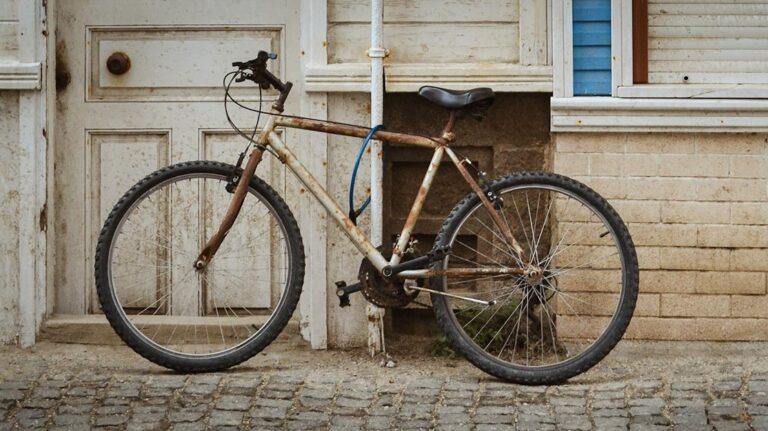Believe it or not, corrosion is one of the most detrimental problems that can affect your bike. Regardless of what kind of frame you have, or how nice your components are, corrosion is the number one killer of bikes and components. From the bolts to the cables, every metal part is subject to corroding and it usually presents in a few different ways. Steel frames and components will develop rust and aluminum will develop a white chalky substance which is called oxidation. Although neither one is extremely problematic in very small amounts, the larger spots and growths can cause some real issues. Rust and oxidation can cause unsightly spots on your frame, blistering paint, swollen cable housings, sticky cables, frozen bolts, sticky headsets, and will even cause parts to come loose from your frame!
Corrosion, as defined by the ever-so-accurate Wikipedia, is described as “the disintegration of an engineered material into its constituent atoms due to chemical reactions with its surroundings”. This sounds pretty technical at first, but when you break it down into a process it is really pretty simple. Essentially, the process of corrosion is an electrical exchange of atoms between a metal and a chemical solution. The metal we are concerned about here would be your bike frame and parts and the solution would be saltwater, rain or puddle water, or a mixture of both. And what human waste fluid is most similar to saltwater? Yup, you guessed it; Human sweat contains a very high amount of salt and minerals which works very well as a corrosive agent. Remember those rusty steel wool experiments in a jar from Chemistry class? Here is where it will have a real world application!
All materials can be rated on a scale based on their reactivity to seawater, which is a highly corrosive liquid due to its high salt and mineral content. In terms of bike frames and components, Aluminum and steel are the most reactive materials. Titanium is the most chemically neutral and Carbon Composite (non-metallic) is so chemically neutral that it isn’t even rated on the scale. Although seawater is at the high end of the corrosion scale, human sweat is not far behind it and its reactivity varies from person to person. Some people have a very reactive PH to their sweat while others are less reactive. Either way, it’s a very reactive chemical and can do some major damage to your frame and components. Ever notice how those beach rental bikes always look like rusty boat anchors and how your chain seems to rust a bit easier after a ride near the ocean?
So how does corrosion affect you and your bike? The negative effects of corroding parts generally fall into one of two categories. Surface corrosion usually presents as small bits of rust or oxidation on the surface of bolt heads, exposed cables, bearing races, or the chain. These surfaces typically are not painted and consequently do not have a fist line of defense against the elements. Secondly, and the more problematic type, is internal corrosion. Internal corrosion occurs when the outer protective surface is somehow compromised and sweat and water get between the metal and it’s coating, through a paint scratch or nick. Swollen paint blisters, bubbling cable housings, frozen bottle cage bolts, frozen seat posts and stems are all fairly common problems and are caused by the swelling and surface destruction that corrosion causes.
Generally speaking, corroding parts and components are the major cause behind many of the common issues I address when working with my customers equipment. Corroded cables and housings cause shifting problems and sticky brakes, and if left untreated could cause some serious issues on race day. Frozen or sticky seat posts can cause major issues when it comes to making an adjustment to a seat position and are often squeaky and noisy. Rusty chains are also very noisy and don’t shift as smoothly as a rust free chain. Chain corrosion and rust can suck as much as 10% to 12% of your power from your pedal stroke. That’s a pretty significant amount of efficiency to lose! Aside from being unsightly, corrosion on your frame and frame parts can also cause some serious problems. If left untreated, an oxidized aluminum frame component, like a cable stop or wheel dropout, could break away from the frame or swell inside the connection to the bike causing the composite to crack. Take a look at the rear wheel dropout in the photo; the part is made of aluminum and has developed some oxidation due to a minor scratch in the paint. Some pretty serious problems!
So how can you avoid the bike killing effects of corrosion? Well, they say cleanliness is next to Godliness, and in this case cleanliness is the answer to your prayers. Keeping your bike clean and lubricated properly is the number one thing you can do to prevent the spread of corrosion. A properly cleaned bike will not only work better, but will last longer and won’t cost as much to maintain over the life of the bike. Removing the sweat (amongst other bodily fluids), sports drink, and six week old chain lube will add life to your bike and often makes a noticeable difference in how it rides. I usually recommend a detailed bike wash about every six weeks or so, depending on the type of conditions you typically ride in. So, remember to keep it clean and look for more to come on bike washing soon, so stay tuned…..

